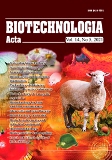ISSN 2410-7751 (Print)
ISSN 2410-776X (Online)

Biotechnologia Acta Т. 14, No. 5 , 2021
P. 49-55, Bibliography 15, Engl.
UDC: 579.222
https://doi.org/10.15407/biotech14.05.049
O. O. Tigunova 1, M. O. Umansikiy 2, V. V. Bratishko 2, A. V. Balabak 3, S. M. Shulga1
1SE “Institute of Food Biotechnology and Genomics of the National Academy of Sciences of Ukraine”, Kyiv
2 National University of Life and Environmental science of Ukraine, Kyiv
3Uman National University of Horticulture, Uman
Aim. The purpose of the study was to investigate the effect of ultrasonic disintegration on the lignocellulosic raw materials (biomass of the non-cereal part of rape) with its subsequent use as a substrate for the production of biobutanol.
Methods. Butanol-producing strains and the biomass of the non-cereal part of rape Brassica napus were used in the present study. Ultrasonic disintegration of lignocellulosic raw materials was performed on the specially designed equipment.
Results. The effect of ultrasonic disintegration on lignocellulosic raw materials was investigated for further application in biofuel production based on microbiological conversion. The possibility of using the obtained components after the pre-treatment of lignocellulose by ultrasonic disintegration as a substrate for the microbiological synthesis of butanol was shown. The highest accumulation of butanol (2.4 g/l) was obtained with the use of 5% dry matter content in the medium, 5 min treatment and the specific power of ultrasonic disintegration of 0.72 W/ml.
Conclusions. The possibility of producer strains of the genus Clostridium to use cellulose in the fermentation process has been shown. When using ultrasonic disintegration for pretreatment of the non-cereal part of the biomass of rape, the accumulation of butanol increased by 3 folds.
Key words: ultrasonic disintegration, biobutanol, lignocellulosic raw materials, biofuel.
© Palladin Institute of Biochemistry of National Academy of Sciences of Ukraine, 2021
References
1. Tursi A. A review on biomass: importance, chemistry, classification, and conversion. Biofuel Res. J. 2019, 6 (2), 962–979. https://doi.org/10.18331/BRJ2019.6.2.3
2. Karimi M., Jenkins B., Stroeve P. Ultrasound irradiation in the production of ethanol from biomass. Renewable and Sustainable Energy Rev. 2014, V. 40, P. 400–421. https://doi.org/10.1016/j.rser.2014.07.151
3. Kumar P., Barrett D. M., Delwiche M. J., Stroeve P. Methods for pretreatment of lignocellulosic biomass for efficient hydrolysis and biofuel production. Ind. Eng. Chem. Res. 2009, 48 (8), 3713–3729. https://doi.org/10.1021/ie801542g
4. Alvira P., Tomas-Pejo E., Ballesteros M., Negro M. J. Pretreatment technologies for an efficient bioethanol production process based on enzymatic hydrolysis: a review. Bioresour. Technol. 2010, V. 101, P. 4851–4861. https://doi.org/10.1016/j.biortech.2009.11.093
5. Shulga S. M., Tigunova O. A., Blume Y. B. Lignocellulose as an alternative source for obtaining of biobutanol. Biotechnol. acta. 2013, 6 (2), 10–20 (In Ukrainian).https://doi.org/10.15407/biotech6.02.009
6. Jaismal N., Agarwal A., Tripathi A. D. Application of microorganisms for biofuel production. In book: Bioenergy Research: Basic andadvanced concepts. Clean Energy Production Technologies. Springer, Singapore. 2021, P. 35–72. https://doi.org/10.1007/978-981-33-4611-6_2
7. Konovalov S., Patrylak L., Zubenko S., Okhrimenko M., Yakovenko A., Levterov A., Avramenko A. Bench motor testing of blended fuels on their basis. Chemistry and Chemical Technol. 2021, 15 (1), 105–177. https://doi.org/10.23939/chcht15.01.105
8. Pinko T., Flores-Alicha X., Gernaey K. V., Junicke H. Alone or together? A review on pure and mixed microbial cultures for butanol production. Renewable and Sustainable Energy Rev. 2021, V. 147, P. 111244https://doi.org/10.1016/j.rser.2021.111244
9. Achkevych O. M. Substantiation of parameters of the drum mixer of feed additives. Abstract of the dissertation of Cand. tech. Science: 05.05.11. National University of Life and Environmental science of Ukraine. Kyiv. 2015, 24 p.
10. Tigunova O. O., Kamenskyh D. S., Tkachenko T. V., Yevdokymenko V. A., Kashkovskiy V. I., Rakhmetov D. B., Blume Ya. B., Shulga S. M. Biobutanol production from plant biomass The Open Agriculture J. 2020, V. 14, P. 187–197. https://doi.org/10.2174/1874331502014010187
11. Bundhoo Z. M. A., Mohee R. Ultrasound-assisted biological conversion of biomass and waste materials to biofuels: A review. Ultrason. Sonochem. 2017. https://doi.org/10.1016/j.ultsonch.2017.07.025
12. Sun R. C., Tomkinson J. Comparative study of lignins isolated by alkali and ultrasound-assisted alkali extractions from wheat straw. Ultrason. Sonochem. 2002, V. 9, P. 85–93. https://doi.org/10.1016/S1350-4177(01)00106-7
13. Velmurugan R., Muthukumar K. Utilization of sugarcane bagasse for bioethanol production: Sono-assisted acid hydrolysis approach. Bioresour. Technol. 2011, V. 102, P. 7119–7123. https://doi.org/10.1016/j.biortech.2011.04.045
14. Raita S., Spalvins K., Blumberga D. Prospect on agro-industrial residues usage for biobutanol production. Agronomy Res. 2021, 19 (s1), 877–895. https://doi.org/10.115159/AR.21.084
15. Anukam A., Berghel J. Biomass pretreatment and characterization: A review. In book: Biotechnology application of biomass. 2020. Open access peer-reviewed chapter. https://doi.org/10.5772/intechopen.93607

